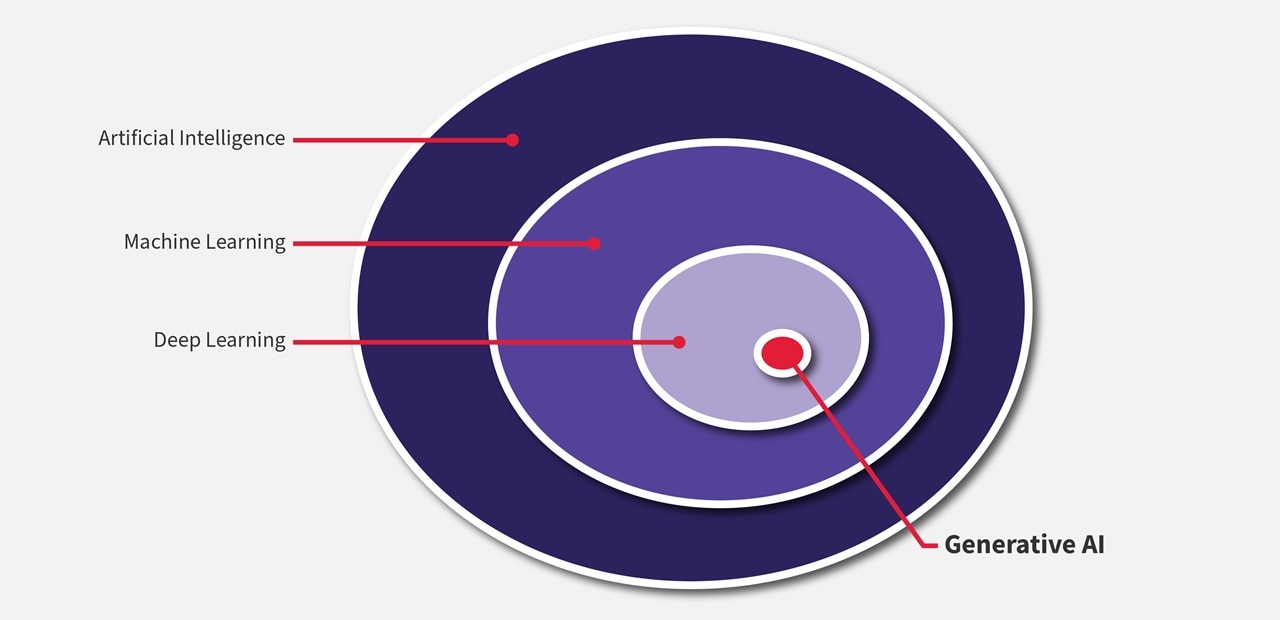How to make sure you’re not leaving money on the table
As a leader with a technical background, I sometimes forget that a technology like AI, and the hype cycle that comes with it, can be a relatively new experience for many. As we continue our conversations about AI with our clients, alliances, and market influencers, we see the discussion coming down to Earth.
However, although organizations have begun to mature their approach to AI, the fundamental understanding of what AI is – and its potential – has for the most part not expanded beyond GenAI. As a result, AI strategy often covers just GenAI strategy. This can lead to increased costs and a lack of the foundations needed to integrate AI solutions, like governance structures, data management, risk management, cybersecurity, cloud infrastructure and more. It can also mean applying GenAI when other AI approaches might be more fitting and cost-effective to achieve the desired outcomes.
Given that ownership, awareness, and interest in AI can span an entire organization, stakeholders must have the same baseline understanding of AI. Otherwise, a lot of the potential value will be left on the table.
AI 101: How to explain AI in a way everyone can understand
Here are a few definitions and an illustration that can help establish a common understanding of AI:
- Artificial intelligence
-
Artificial intelligence (AI) is a machine-based system that mimics human reasoning, perceives its environment, pursues goals, adapts to feedback or change, and provides information or takes action. It is a toolbox of different capabilities, ranging from computer vision, prediction, forecasting, pattern discovery, and optimization (enabled by machine learning techniques and models) to the large language models (LLMs) and foundation models driving today’s GenAI.
- Machine learning
-
Machine learning (ML) is a subset of AI designed to continue to “get smarter” as more training information is provided, in a way that programmatically mimics human reasoning. This may include models used for prediction or advanced decision-making.
- Deep learning
-
Deep learning (DL) is a subset of machine learning that adds many more (deep) layers of neurons to learn patterns from training data. Deep learning involves training a computer, through neural network models, to learn from extensive datasets, similar to how humans acquire knowledge. For instance, to enable a computer to identify various animals, one would train it to recognize the differences in thousands of images. The computer learns patterns and abstractions of data, not the entirety of the data itself. When presented with a new image, the computer can apply its learned knowledge from the training images to determine patterns for which animal the image represents.
- Generative AI
-
Generative AI (GenAI) is a generic term that is mainly a subset of deep learning, including non-deep learning techniques and more traditional algorithms. It uses advanced models—e.g., foundation models such as LLMs or large multimodal models (LMMs)—to generate or manipulate natural language, images, or other data types. GenAI solutions can help businesses create engaging content, provide personalized customer service, generate new software code, or enhance workflows with natural language understanding.
The following diagram is a simplified visual representation how AI is more than just GenAI:
Why AI is more than GenAI
Note: This diagram is simplified to illustrate relationships, but not the relative scale of investments or other measures. It does not reflect nuances such as non-deep learning techniques that would fall within GenAI.
To take this to a more concrete level, the following are some examples of our AI collaborations with clients:
Traditional AI examples: These projects involve well-established AI techniques and tools. They often use statistical methods and ML algorithms to analyze data, predict outcomes, provide recommendations or automate interactions. For example:
- A predictive model to estimate the risk of accidents for an insurance company
- An ML model to provide more precise information for demand forecasting to support supply chain decisions
- A deep learning system to analyze medical images and assist in diagnoses
- A multi-model AI system that combines computer vision and sensor data to optimize manufacturing production processes and quality control
Generative AI examples: Whereas traditional AI classifies, predicts, optimizes, and forecasts, GenAI creates new assets or original content, for example:
- A content generation tool for a marketing firm that uses a foundation model to produce creative ad copy based on brief prompts
- A plug-in into a developer’s integrated development environment to generate new code
- An insight-generation solution to allow business users to access hidden patterns in large data sets
Avoiding missed AI opportunities and increased costs
What happens when an organization only applies GenAI to solve a business challenge?
Let’s look at a typical manufacturing problem, such as detecting defects in machinery: Say you know from experience what types of defects are typical to the machinery and where to look, you’ll be better off training a machine learning model for this purpose. It would take a few weeks to months to develop, but the solution would be built to your needs, with the highest accuracy and quality and lower operational costs over time. If you were to apply a GenAI solution instead, while it would be ready much faster, over time the operational costs could be much higher.
This is because GenAI models have many more training parameters (up to 200 billion) than traditional AI models (up to 200 million). Traditional AI models can run on a consumer-grade graphics processing unit (GPU) for less than US$1,000. Originally used for 3D gaming, GPUs are now the standard for AI applications for their ability to handle the parallel processing needed to train AI models. CPUs can be used for training smaller models but are not well-suited for larger models. In contrast, in inference costs, a GenAI model may require a professional-grade GPU for about US$1,400 per month. The purchase price per card can be US$20K to $40K. A 90 billion parameter (90B) Llama model could cost two to four times these amounts in hardware costs.
Where might a GenAI solution make sense in this example?
- If you need a quick fix, a GenAI solution could be a stopgap measure or used to demonstrate the value of AI. You could then build the machine learning model in parallel or afterward.
- If you need to find defects you haven’t identified yet or don’t know where they tend to occur and you want to detect, for example, structural anomalies. This data could also be used for a future purpose-built, lower-cost machine-learning model.
- If you need a higher level of accuracy for specific language tasks, such as natural language processing, a higher compute-cost GenAI solution might be required.
- If you need to accelerate your software development processes, a GenAI development solution would be required. • If you have additional constraints in place, such as limited access to talent.
Given the challenging economic environments in multiple G20 countries, CGI’s Voice of Our Clients research shows that manufacturers plan to diversify into new markets with new product lines. Therefore, shortening product development cycles represents a competitive advantage. Using GenAI to achieve these goals can be advantageous because of speed, flexibility, and the ability to handle complex, unstructured data. Here, the potential for rapid innovation and quicker time-to-market can, in some cases, make it a cost-effective solution in the long term, particularly where adaptability and cutting-edge design are essential.
Integrating the best of all worlds
The good news is the choice doesn’t always have to be either/or. There are ways to combine the best technologies to deliver better results, quality, and capabilities at a lower cost.
For example, there are many things that traditional monitoring solutions (i.e., simple telemetry and IoT sensors) cannot detect, and many scenarios where physical, human inspection of assets is impractical or where monitoring by video or camera produces data that cannot be usefully interpreted.
Our AI experts in Australia developed CGI Machine Vision to address this business challenge. It uses deep neural network AI and edge computing to extract sensor data. AI processes data captured by cameras, drones, and other devices at the collection site, and only relevant data is pushed to operations. The edge computing component eliminates transmission delays and bandwidth concerns.
What would this capability mean in our manufacturing example? Suppose you have a drone sensor or camera that monitors your machines with this added layer. In that case, you can give commands using the GenAI interface and execute actions based on whether specific issues are detected. For example, the marked deterioration could be detected and relayed in real-time, triggering an automatic action (e.g., create a report, send a signal, etc.). The GenAI model also learns along the way to make this response even better.
This example could be further extended in a multi-model ecosystem where a layer of GenAI can be added to allow users to interact with the data using natural language. This digital triplet approach uses AI to extend the digital twin model, or an existing investment in data and documented information, to help organizations interrogate the information. This allows the exploration of connections between data to make more personalized, evidence-based, and transparent decisions. It also allows a user to get expert advice on different scenarios and recommendations over text, voice, or radio through natural language outputs to increase the usability and ROI of the AI investment.
Where do we go from here?
Understanding that AI is more than just GenAI is critical to implementing effective solutions for your biggest challenges, not just AI for the sake of AI or endless proofs-of-concept across your business. GenAI on its own, without the right foundation and right context, will not deliver tangible outcomes. By getting to a baseline understanding, we can stop talking about AI and fully unlock how it can deliver business outcomes and value.
If you would like to cut through the hype and explore how to accelerate value realization at a lower cost, please visit our artificial intelligence page to learn more or connect with me, or the experts contributing to this blog shown below, to continue this conversation.
Back to top










